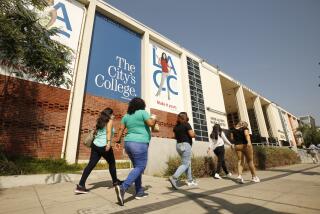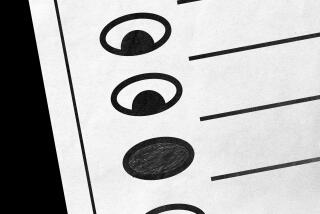Opinion: How do you pick a good judicial candidate? Here’s what you need to know
- Share via
The biggest question in today’s California election may be Bernie versus Hillary, but every voter in Los Angeles County has at least seven little questions as well: How should we mark our ballots in the races for Superior Court judge?
Judicial elections are a little weird. There is no shortage of information about presidential candidates, and in fact there often seems to be a discomforting overload of talk about the race for the White House – but there is very little out there for voters who want to make responsible choices for judge. Even people who do as much homework as they can may find few options beside relying on the advice of strangers, or else puff from the candidates themselves.
Some of that puff ends up in the ballot pamphlet. Candidates have the option of purchasing a page in the official document that is mailed or emailed to all voters, and to use the space to make a pitch directly to the electorate. In L.A. County, the cost to the candidate runs in the tens of thousands of dollars, and not everyone can afford it. The practice has been criticized as an improper use of official voter materials.
But then we’d be giving voters less information about judicial candidates, not more.
And of course each candidate’s name on the ballot is followed by a three-word title or designation that is supposedly an even-handed description of that person’s current job, like “deputy district attorney.” But the candidates get to write their own job descriptions and they rarely choose such a boring one. As The Times noted recently, deputy district attorneys are a lot more successful at the polls if they use words like “violent crimes prosecutor.” Which they can do, even though there is in reality no such job title.
Wouldn’t it be more fair for the ballot to list just the names, without the puffy ballot titles?
It would, and so would getting rid of paid statements in the ballot pamphlet. But then we’d be giving voters less information about judicial candidates, not more.
Until the late 1990s, California had municipal courts – smaller courts that handled only misdemeanors on the criminal side and smaller lawsuits on the civil side. Many municipal courts had boundaries that were the same as small or mid-sized cities. Pasadena, Glendale, Long Beach and Pomona each had municipal courts, for example, as did many other areas – and candidates could go door-to-door or meet voters at community forums. Voters could more easily do their research and make their choices. But municipal courts are gone, and a candidate from Pomona has to make his or her pitch to voters in Palmdale, Pasadena and everywhere else in the county. There is the occasional candidate forum. But for the most part, judicial candidates get the biggest bang for their campaign buck by doing their marketing to voters on the ballot itself.
That leaves voters with the other option – relying on advice, getting it from as many different sources as possible, weighing the time and work of those giving the advice, and making as educated a choice as possible.
The Times editorial page offers its advice on judicial candidates in the form of endorsements, which are reiterated in Tuesday’s edition and also available here and here. In three of the races, a deputy public defender, a lawyer in private practice and a lawyer who stopped practicing for several years to go into business are challenging incumbent judges. Because each of those races has only two candidates, victors will emerge in the primary and there will be no runoff.
The other four seats on the ballot are or will soon become vacant, and each has more than one candidate. If no candidate gets more than 50% of the vote in each race, there will be a Nov. 8 runoff between the two top finishers.
Email: [email protected]
Twitter: @rgreene2
More to Read
A cure for the common opinion
Get thought-provoking perspectives with our weekly newsletter.
You may occasionally receive promotional content from the Los Angeles Times.










